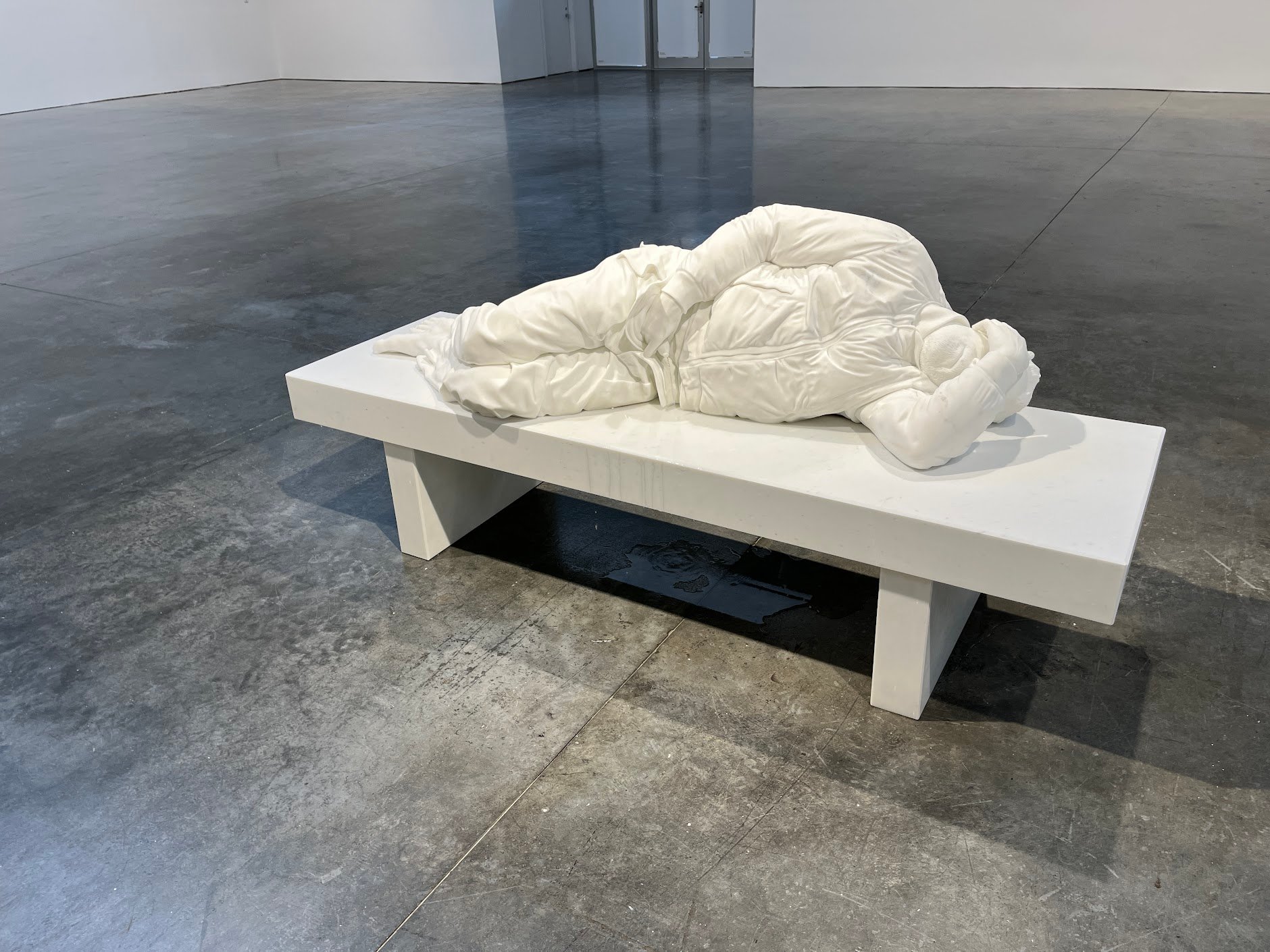
The Italian artist Maurizio Cattelan has created some of the most outrageous, fury-generating sculptures of our times. Pope John Paul II felled by a meteorite. The solid-golden toilet titled America. The $120,000 banana taped to a wall. His latest creation, which goes on view at Gagosian gallery in New York this evening, is a bit different. By Cattelan standards, it is positively subdued.
At the center of its cavernous West 21st Street gallery is a sculpture of a middle-aged man lying on a bench, his back to the entrance. Made of marble, it is a brilliant white, and every detail has been meticulously carved: the undulating fabric of his jacket, his bare feet, the veins on his hands. One of those hands is shielding his bearded face, and the other is—oh!—it is in his unzipped pants, holding his phallus, which emits water onto the bench that drips to the ground below. (The liquid comes from a reservoir inside the piece.) It is a startling sight, but it is also entirely possible that you encountered more shocking imagery on your subway ride to the gallery.
Cattelan has been characteristically cryptic about the work, which is titled November (2024). He told the New York Times that it depicts a friend and a collaborator who died, and that it recalls “the swaths of people who are invisible in society.” From one vantage point, it certainly ranks as one of his more earnest efforts, invoking the housing crisis in New York and elsewhere (and our baleful lack of public restrooms in the United States). You might also detect an element of wry institutional critique: a man peeing on the floor of this big-money, white-walled gallery. (A nod to David Hammons peeing on a Richard Serra sculpture, perhaps?)
Maurizio Cattelan’s Sunday (2024) installation at Gagosian gallery in New York.
The only other artwork in Cattelan’s exhibition is even more forthrightly political. Titled Sunday (2024), like the show itself, it consists of 64 square steel panels that have been plated with 24-karat gold, sprayed with bullets, and hung together on a wall—a fairly obvious representation of America’s twin obsessions: money and violence. Each of the panels, which one might generously compare to Lucio Fontana’s punctured canvases, will be sold separately. The less said about them, the better.
Politics aside, Cattelan’s figure follows in a rich tradition of artworks that feature pissers. The peeing boys are the most famous—Manneken-Pis, the mascot of Brussels, is one—but as the French art historian and critic Jean-Claude Lebensztejn notes in his indispensable 2016 volume Pissing Figures: 1280–2014, all types of people have been peeing all over the place in art history, from ancient Roman sarcophagi to manuscripts of the Renaissance. During that latter period, “diuretic fantasies also infiltrated sacred spaces, where piss could take on a purifying function,” he writes.
Over the past few millennia, public urination in art has offered amusement, titillation, and mischievous joy. Here it reads as a symbol of personal freedom, quietly but decisively won. Cattelan’s whizzer is not being showy about it. He does not mean to offend. He is transgressing, yes, but he also seems to be lost in thought, eyes closed. He might be dreaming. (He vaguely recalls the down-and-out Sleeping Woman, 2012, that Charles Ray showed at the nearby Matthew Marks Gallery a dozen years ago.)
How will the public perceive Cattelan’s sculpture of his friend? One can imagine its salacious content drawing crowds of people, eager to gape. But spend some time with this piece, and any notion of spectacle fades. This is a man trying to have a private moment. We have all been there before. Give him a long look, and then let him do his thing.